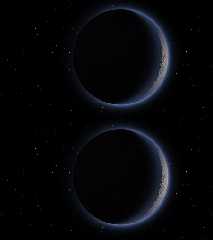|
 |
clipka <ano### [at] anonymous org> wrote:
>
> - If you're working in the field of planetary photometrics, you probably
> want to use Lommel-Seeliger.
Don't see these newsgroups much anymore and by chance found your new diffuse
implementation being talked about. Finally gave it a try after getting the
latest version (123). Thanks for providing the opportunity!
I don't actually work in planetary photometrics, just play. Ever since the Pluto
pictures were shown last summer I began trying to simulate its surface and
atmosphere using POV-Ray.
isosurface uses crude global image from the New Horizons mission, not a true
elevation map, that I just tweaked on to get usable. The 'media' atmosphere is
just a guess based on how it looks in photos.
Images compared here are the default diffuse, 0.6, with 'albedo' added, at top.
Bottom is lommel-seeliger 0.6 and although you might not see the difference
right away please look closely at the upper and lower portions of the sunlit
crescent.
Also especially not obvious at this picture size is how the sunlit horizon edge,
next to space as opposed to shadow terminator, is kept brighter with
lommel-seeliger.
Unfortuntely this is about all I have done to compare, only using 0.8 and this
one 0.6 as the lommel-seeliger value. In fact I didn't even try the other
diffuse model yet, but here's what I've added to my Pluto scene file for the
finish statement:
finish
{
//emission <0.15,0.05,0.005>*<1.5,0.75,0.5>
//ambient <0.15,0.05,0.005>
brilliance 3 // um, yeah, whatever for this!
diffuse albedo 0.6
#if (SurfaceDiffusion=on)
//oren_nayar 0.7 // not tried yet
lommel_seeliger 0.6
#end
specular 0.8
roughness 0.2
metallic 0.8 // just experimenting too
}
Little I know of this stuff but to me it does look promising for surfaces of
planets, moons, asteroids, comets... org> wrote:
>
> - If you're working in the field of planetary photometrics, you probably
> want to use Lommel-Seeliger.
Don't see these newsgroups much anymore and by chance found your new diffuse
implementation being talked about. Finally gave it a try after getting the
latest version (123). Thanks for providing the opportunity!
I don't actually work in planetary photometrics, just play. Ever since the Pluto
pictures were shown last summer I began trying to simulate its surface and
atmosphere using POV-Ray.
isosurface uses crude global image from the New Horizons mission, not a true
elevation map, that I just tweaked on to get usable. The 'media' atmosphere is
just a guess based on how it looks in photos.
Images compared here are the default diffuse, 0.6, with 'albedo' added, at top.
Bottom is lommel-seeliger 0.6 and although you might not see the difference
right away please look closely at the upper and lower portions of the sunlit
crescent.
Also especially not obvious at this picture size is how the sunlit horizon edge,
next to space as opposed to shadow terminator, is kept brighter with
lommel-seeliger.
Unfortuntely this is about all I have done to compare, only using 0.8 and this
one 0.6 as the lommel-seeliger value. In fact I didn't even try the other
diffuse model yet, but here's what I've added to my Pluto scene file for the
finish statement:
finish
{
//emission <0.15,0.05,0.005>*<1.5,0.75,0.5>
//ambient <0.15,0.05,0.005>
brilliance 3 // um, yeah, whatever for this!
diffuse albedo 0.6
#if (SurfaceDiffusion=on)
//oren_nayar 0.7 // not tried yet
lommel_seeliger 0.6
#end
specular 0.8
roughness 0.2
metallic 0.8 // just experimenting too
}
Little I know of this stuff but to me it does look promising for surfaces of
planets, moons, asteroids, comets...
Post a reply to this message
Attachments:
Download 'diffuse-albedo_ls-compared.jpg' (29 KB)
Preview of image 'diffuse-albedo_ls-compared.jpg'

|
 |




![]()